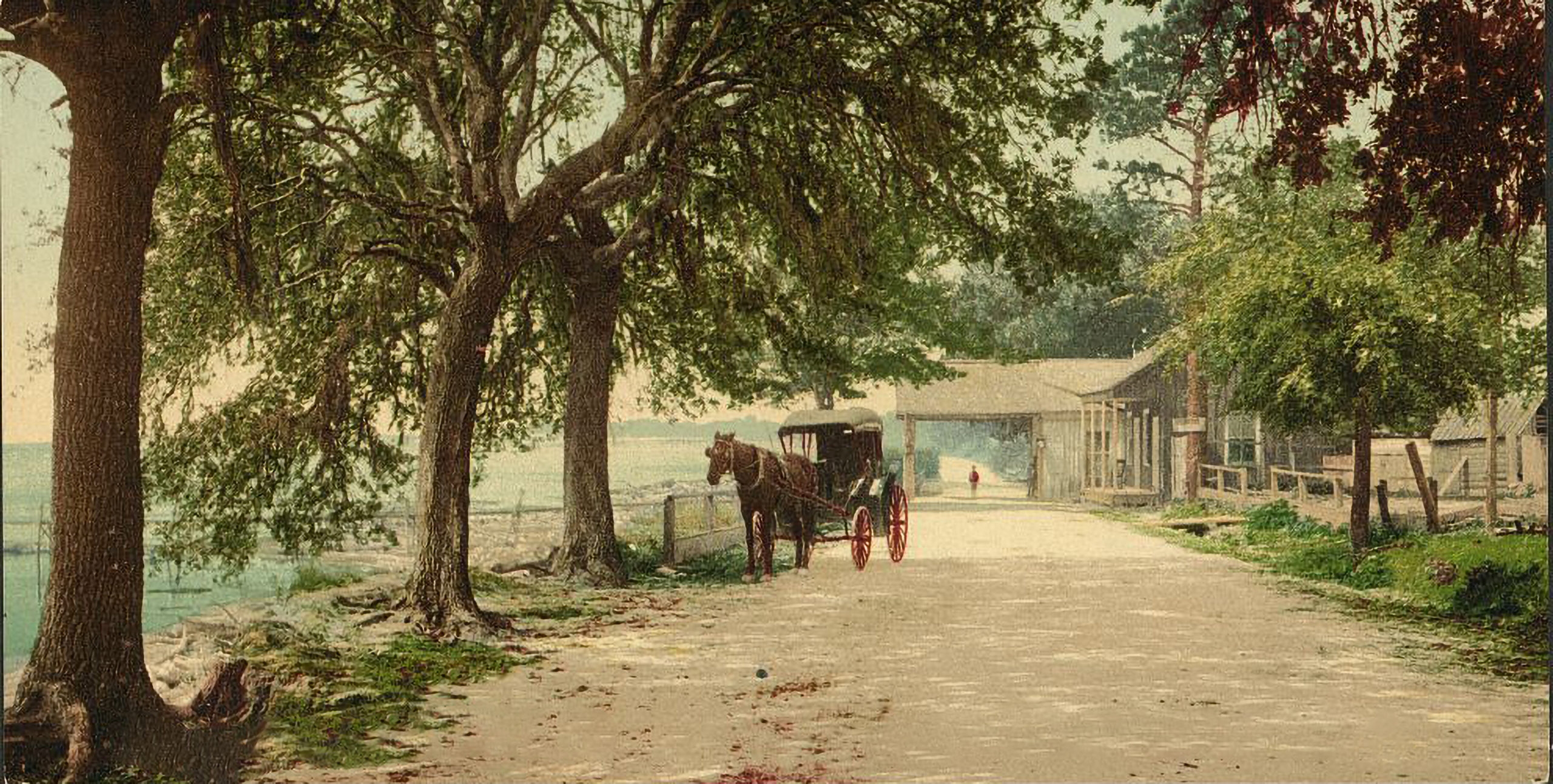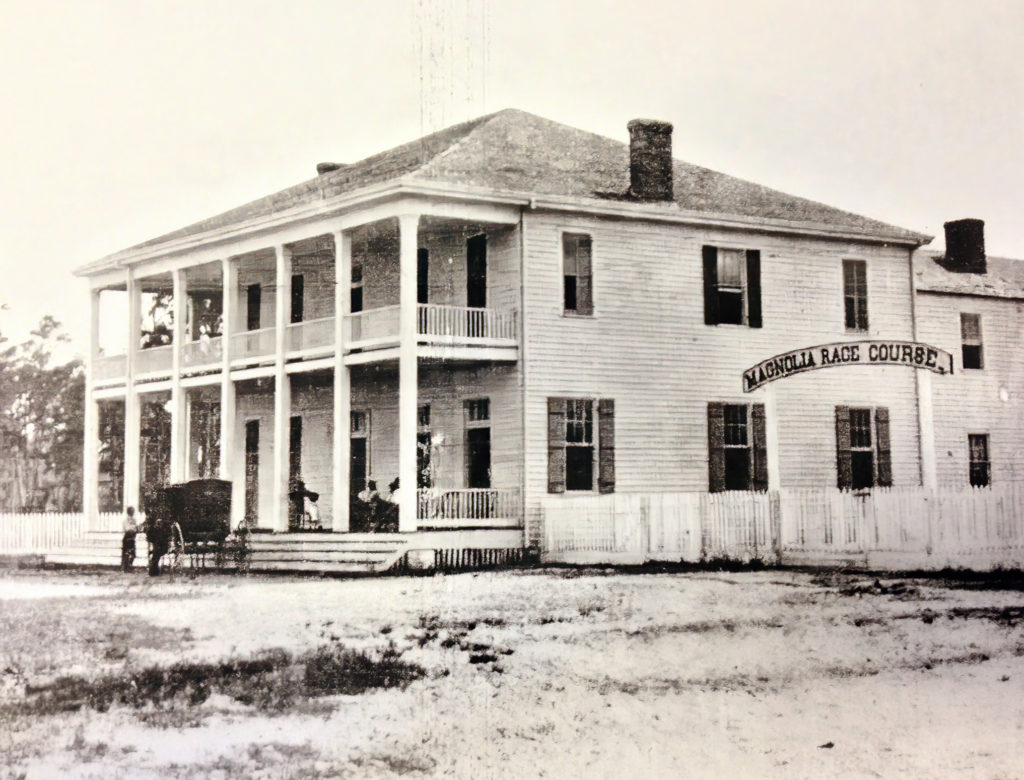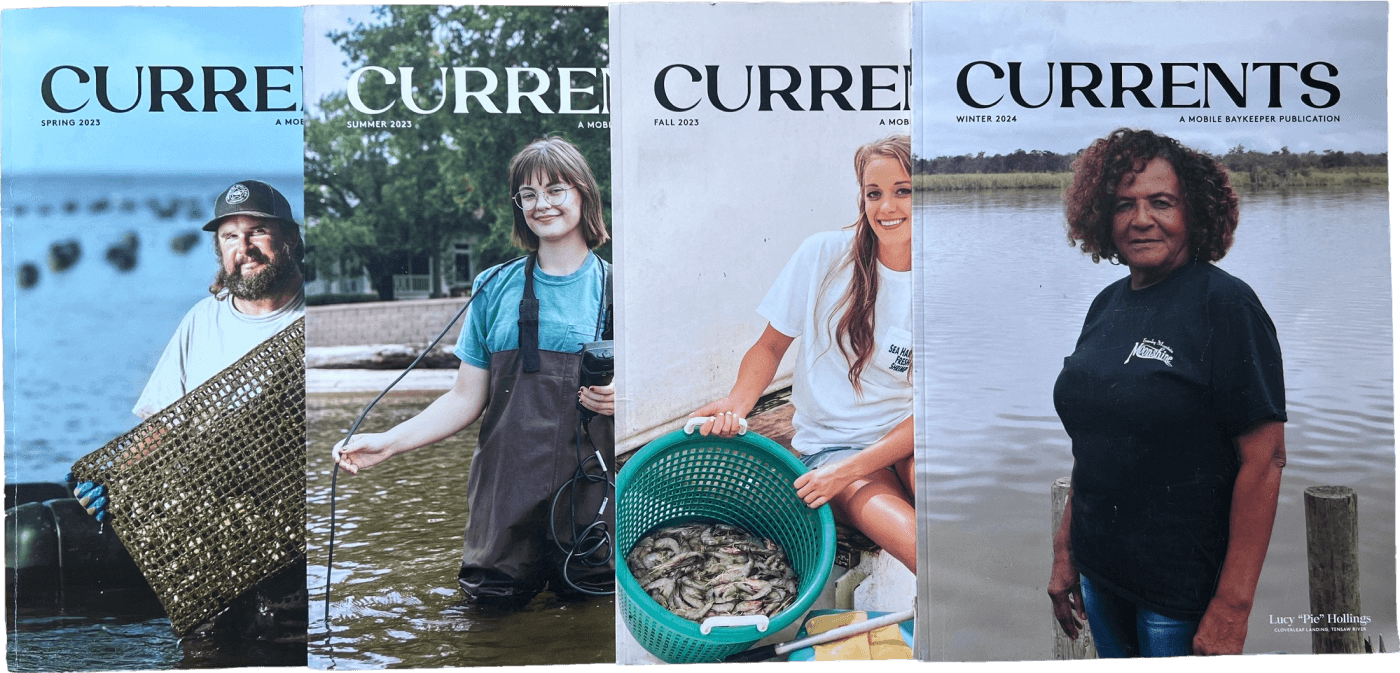
This article is from the spring 2024 edition of Mobile Baykeeper’s print quarterly, CURRENTS. The magazine is mailed to active members who have given more than $50 in the past year. To get on the magazine’s mailing list, donate here.
By Susan Rouillier
In the spring of 1870, an intense buzz filled the air in historic Mobile as anticipation mounted for the inaugural two-mile hurdle race at the renowned Magnolia Race Course. Horse-drawn carriages clattered along the rugged Bay Shell Road, the rhythmic clip-clop of hooves creating a cadence against the backdrop of Mobile Bay. The air was thick with the refreshing scent of the Bay waters, intermingled with the fragrant lemon whispers of magnolias that dotted the path along the way.
Under the sprawling canopy of ancient oak trees adorned with swaying Spanish moss, the travelers found refuge from the Southern sun, their passage serenaded by the distant call of seabirds accompanying the carriage’s steady slow progression on the 5-mile trek that hugged the Bay shoreline.
Spirits were high when, in the distance, the Magnolia Race Course emerged, a beacon promising excitement and fervor amidst the serene landscape. The March afternoon sun was gentle, but the travelers knew this calm was a prelude to the drama soon to unfold at the tracks: the first two-mile hurtle race to be held in Alabama.
Eyewitness Account of the Journey to the Race Course on Bay Shell Road
(Mobile Daily Register, March 23, 1870)
Never before in the history of the turf was there a prettier day than yesterday for the inauguration of the Spring Meeting over the Magnolia Course. The heavens smiled most propitiously upon the occasion, and long before the arrival of the hour when the sound of the bell from the judge’s stand called the contestants for the first race upon the track, the beautiful drive along our bay shore was threaded throughout its entire length with visitors, anxious to witness the first hurdle race ever run under racing rules on the Magnolia track. The bay was calm and smooth, not a ripple disturbed its placid beauty, and yes, there were gentle breezes wafted through the air which gave an additional charm to the drive and made it all the more exhilarating. Betting aside, all high-flown speeches, and coming down to plain talk¸ the attendance yesterday was the best that has been had since the war, and there was a good sprinkling of the fair sex.
Eye-Witness Account of the Exciting First Two-mile Hurdles Race Ever Held at Magnolia Race Course
(Mobile Daily Register, March 23, 1870)
The start was a first rate one, Mitchell having rather the advantage over Lobelia and maintaining it, as will appear, pretty well. No deer could have bounded over a fence with more ease and grace than did these two beautiful specimens of horse flesh. The bushes were scarcely ruffled in a single instance of the eight that had to be overcome. The lead of almost two lengths taken by Mitchell was steadily held until nearing the third hurdle on the second mile, when the brown mare began to close the gap, and went over the last hurdle hardly half a second in the advance. The last quarter was fought with desperation. The whip and spar was freely applied by both riders, but it was of little service to Mitchell, for Lobelia passed the string about half a length ahead, having made the first mile in 1:57, the second in 1:59, the race in 3:56 and with one exception, when in New Orleans 3:52.5 was recorded, the best time known in the American hurdle calendar.
The Magnolia Race Course: Everyone was Welcome
Located a half-mile inland from Mobile Bay, the Magnolia Race Course could be reached by horse and wagon by traveling about five miles along Mobile Bay’s shoreline on Bay Shell Road. The race course could also be accessed by water. Gamblers and visitors docked their boats at Magnolia’s pier which led to the large Magnolia Hotel, where bets were placed on races at the 2.5-mile-long track behind the hotel. Racing fever was always at red-heat and betting on horses was egalitarian: anyone could bet … men, women, Creoles, Indians, officers, soldiers, and people of color were all welcome. Many jockeys were African-American. The Thoroughbred breeding farm and breeding sheds that gave life to spirited winning horses were on property behind the track. The most important Thoroughbred to emerge from Magnolia’s breeding farm was Buchanan, who won the Kentucky Derby in 1887.
The depiction offered by stereopticon images dating back to 1870, coupled with articles from the Mobile Daily Register, vividly paint the historical narrative surrounding this renowned horse-racing track.

Discovering the Exact Location of the Magnolia Race Course
Ninety-nine-year-old Bay Front Road resident, Fred Lorge, spoke of an old horse-racing track in the 1930s near Rosedale Road when he was a young boy. “It was old then, but you could walk around it,” he said. An 1857 survey for a proposed site location for the Magnolia Race Course showed that it was near Mobile Bay, but not exactly where. Confirmation of its location came from a 1939 U.S. Army Corps of Engineers aerial map that clearly showed the outline of a large empty horse-track shaped area standing out from the surrounding green treetops exactly where Mr. Lorge said it was. (I superimposed a current map on top of the 1939 map, aligning Cedar Crescent Roads to reveal that the location of the old Magnolia track lies directly under the current Mobile Aeroplex Runway.)
Why Was a Race in Saratoga, New York Named “The Alabama Stakes” in 1872, So Soon After the Civil War?
The answer lies in the life of the developer of Magnolia Race Course and stables, Captain William Cottrill. English by birth, Cottrill came to Mobile in 1841 at age 26 and began working with his brother-in-law in the butcher business. Mobile was home to the Bascombe Race Course near Magnolia Cemetery and it wasn’t too long before Cottrill joined the racing fold. In fact, Cottrill rode in the country’s first hurdle race, at Mobile’s Bascombe Race Course in the late 1840s. His involvement in the racing industry steadily grew as he turned his attention to buying and running Thoroughbreds.
During the Civil War, Captain William Cottrill was in command of a cavalry company, and once the conflict had ended, he purchased the Magnolia track. His interests turned to raising and training Thoroughbreds numbering in the hundreds.
Cottrill is credited with reviving racing in the North in the years following the Civil War. In the late 1860s he found success on tracks in the north and east in such races as the West End Hotel Stakes at Long Branch, New Jersey, which he won three years running from 1869 to 1871. Expanding his reach even further in the racing world, Cottrill’s horses began running at tracks in Chicago, St. Louis, Memphis, New Orleans, and elsewhere. The postwar reconstruction of New Orleans’s racetrack, now called the Fair Grounds, became Cottrill’s turf, because his horses dominated the meets there from the track’s reopening in 1872 until well into the next decade. The 1880s brought the Captain’s greatest racing success with his best horse Buchanan’s win in the 1884 Kentucky Derby.
He was admired by fellow horsemen and, after his death in 1887, was described as “universally esteemed for his many good qualities of head and heart … he was an ornament of the turf.” (The Kentucky Livestock Record, 1887) When he was approached to have a race named after him, he modestly declined. In 1872, the Alabama Stakes was named in Cottrill’s honor by Saratoga officials and has been run every year since. Today the Alabama Stakes carries a purse of $600,000. Cottrill is buried at Magnolia Cemetery in Mobile.
Top image: Bay Shell Road, 1901. Library of Congress.
Images and Information: History Museum of Mobile, Mobile Municipal Archives, Local History and Genealogy, Mobile Public Library, Library of Congress, Mobile Register, Mobile Daily Tribune.
Before moving to her current home on Mobile Bay, Susan Rouillier (susierou.com) lived in Cuba, Japan, and Australia. She is the author of South Mobile: 1699-2018, a three-hundred-year history of the area between Dog River and Brookley Air Force Base, available on Amazon.
